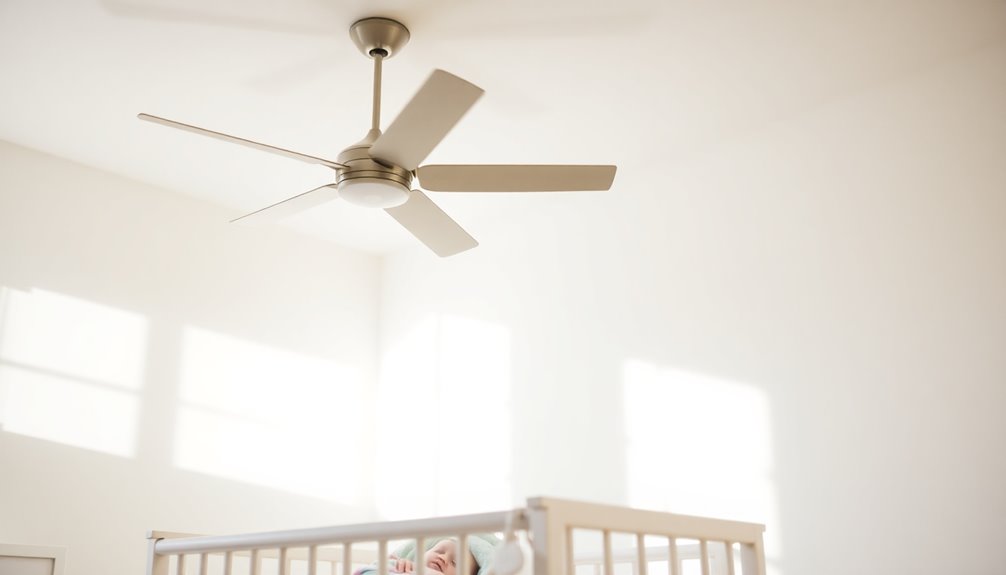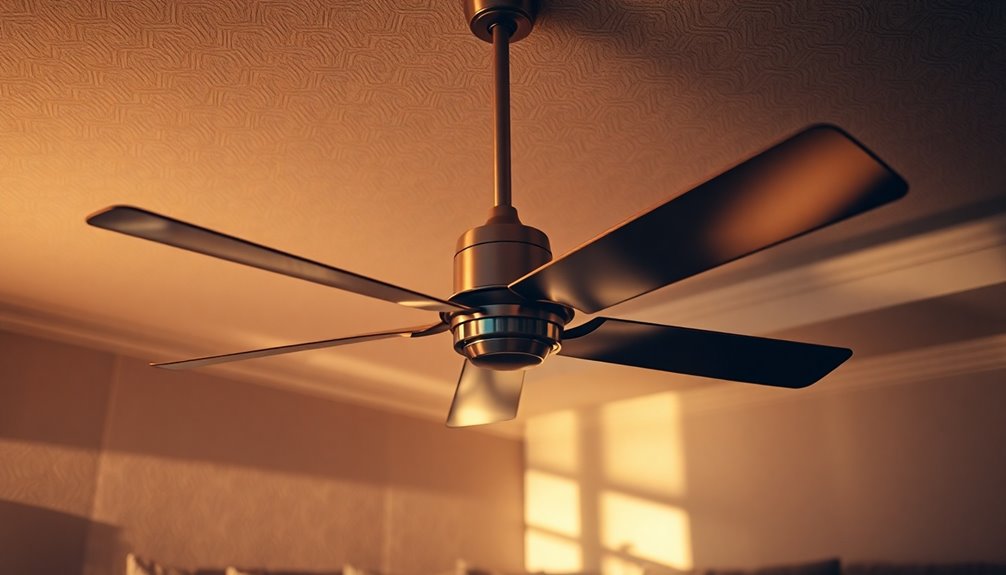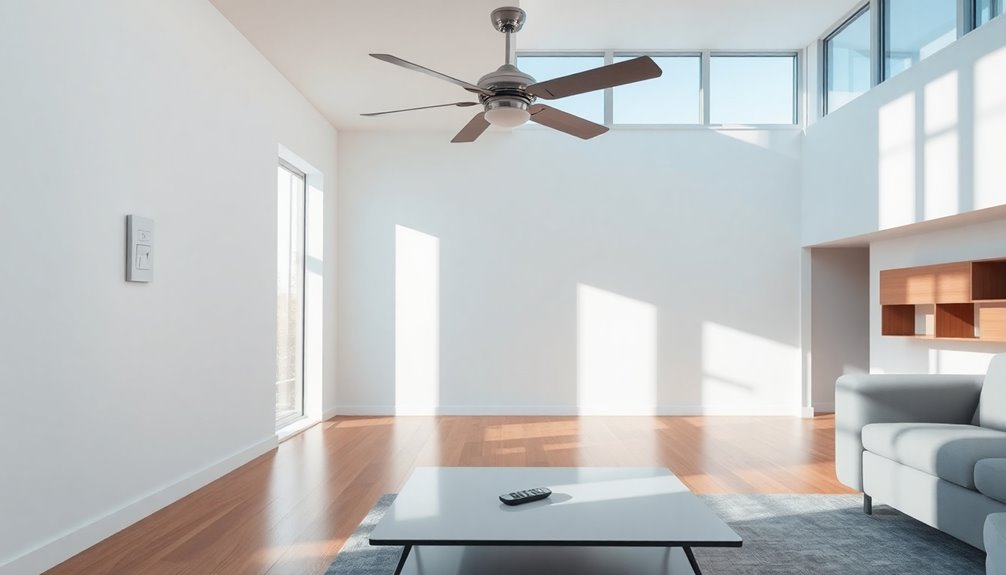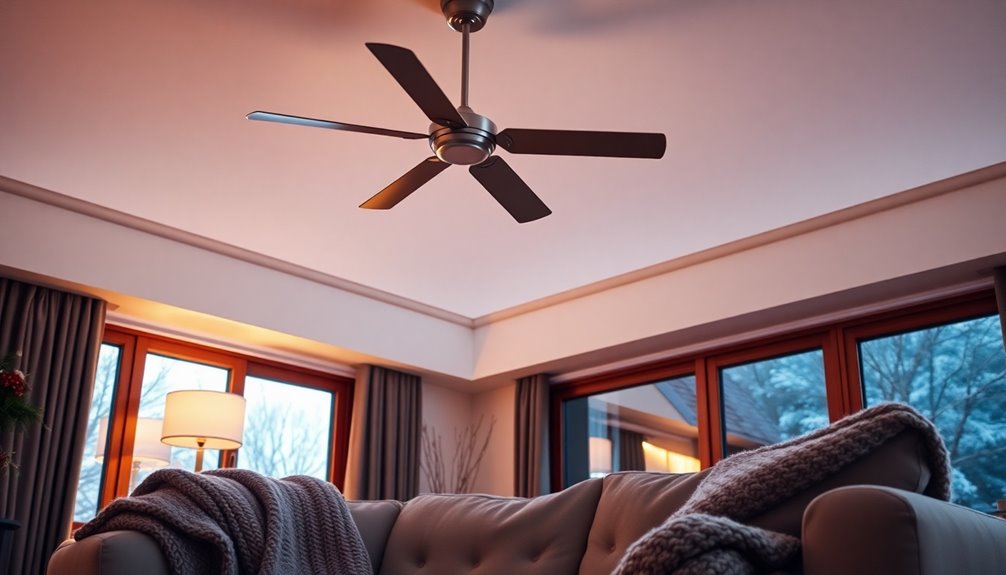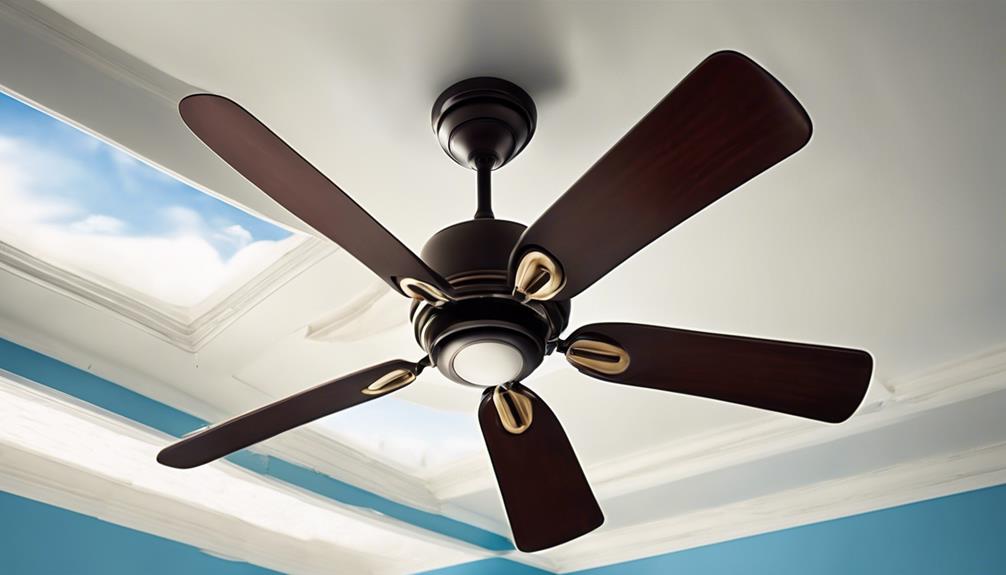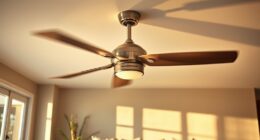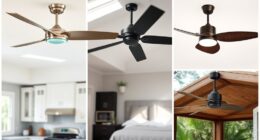Ceiling fans aren't bad for babies; they can actually enhance air circulation and comfort. Better ventilation helps reduce the risk of SIDS by lowering carbon dioxide levels in the nursery. Fans create a soothing white noise that can aid your baby's sleep. When properly installed, they're safe and efficient. Regular maintenance is essential to guarantee they're in good working condition and out of reach. Overall, using a ceiling fan can create a healthier sleeping environment for your little one. If you want to know more about safe nursery practices, just keep exploring the topic further.
Key Takeaways
- Ceiling fans improve air circulation, enhancing comfort and reducing the risk of overheating, which is essential for infant safety.
- Enhanced airflow from ceiling fans can help lower the risk of Sudden Infant Death Syndrome (SIDS) by dissipating carbon dioxide.
- Properly positioned ceiling fans create a soothing environment with white noise, promoting better sleep quality for infants.
- Ceiling fans maintain balanced humidity levels, preventing skin irritations while ensuring a comfortable nursery atmosphere.
- Regular maintenance and safe installation of ceiling fans are crucial to ensuring they do not pose hazards to infants.
Importance of Ventilation

Ventilation is crucial for your baby's safety and well-being. Inadequate ventilation can trap exhaled carbon dioxide near your infant's mouth and nose, increasing the risk of Sudden Infant Death Syndrome (SIDS).
When airflow is restricted, as it can be with soft bedding or certain sleeping positions like stomach or side sleeping, your baby may inadvertently re-breathe carbon dioxide. This decreases oxygen levels and heightens the chances of serious health risks.
Covering your baby's head during sleep can considerably reduce ventilation, compounding these dangers. To protect your little one, make certain their sleep environment allows for proper air circulation.
Pediatricians recommend a well-ventilated area to support your infant's respiratory health during sleep. Improved airflow helps mitigate the risks associated with SIDS by preventing harmful carbon dioxide buildup.
Consider using ceiling fans or opening a window to promote ventilation, but confirm they won't create drafts that could be uncomfortable for your baby.
Safe Sleep Practices

Creating a safe sleep environment for your baby involves more than just guaranteeing good airflow. You need to follow safe sleep practices to protect your little one from risks like Sudden Infant Death Syndrome (SIDS).
Always place your infant on their back for sleep. This consistent position greatly reduces the chances of SIDS and promotes safer sleeping habits.
Make sure your baby's sleep surface is firm, such as a crib mattress specifically designed for infants. Avoid using soft items like quilts, pillows, or blankets in the crib, as these can pose suffocation risks.
Keeping the sleep area clear of any hazards is essential. Additionally, verify that the room is well-ventilated without any drafts or direct airflow hitting your baby, as this can disrupt their sleep.
You should regularly check the temperature to confirm it's comfortable.
Benefits of Ceiling Fans

Ceiling fans offer several benefits that can create a better environment for your baby.
They improve air circulation, regulate room temperature, and enhance sleep quality, making it easier for your little one to rest soundly.
With these advantages, you might find that a ceiling fan is a valuable addition to your nursery.
Improved Air Circulation
Improving air circulation in your baby's room can make a significant difference in their comfort and safety. Ceiling fans are an effective way to enhance this circulation, helping to prevent carbon dioxide buildup. This improvement can reduce the risk of Sudden Infant Death Syndrome (SIDS) by up to 72% when used in well-ventilated spaces. Additionally, regular maintenance of heat pump systems can further optimize indoor air quality, contributing to a healthier environment for your baby. Furthermore, creating a traditional tea ceremony atmosphere can also promote relaxation and mindfulness in the nursery.
Moreover, maintaining proper air filtration in the room can enhance the overall air quality, ensuring your baby breathes cleaner air. This is especially important since HEPA filters are known to capture a significant amount of harmful particles, contributing to a safer indoor environment. Additionally, the gentle airflow from ceiling fans creates a more pleasant sleeping environment, allowing your infant to sleep better and longer. They even provide soothing white noise, which can mask disruptive sounds, promoting deeper sleep for both you and your baby. Pediatricians endorse the regular use of ceiling fans in nurseries because they enhance air quality without changing humidity levels. Furthermore, maintaining a safe sleep environment is crucial for your baby's overall well-being.
Here's a quick overview of the benefits:
| Benefit | Description | Impact on Baby |
|---|---|---|
| Improved Air Circulation | Prevents carbon dioxide buildup | Reduces SIDS risk |
| Enhanced Comfort | Maintains stable temperature | Promotes better sleep |
| Soothing White Noise | Masks disruptive sounds | Encourages deeper sleep |
| Pediatrician Recommended | Safe for infant care | Boosts overall safety |
| Easy to Use | Simple installation and operation | Convenient for parents
Temperature Regulation Benefits
When it comes to keeping your baby comfortable, maintaining an ideal temperature in their room is essential. Ceiling fans play a significant role in temperature regulation, helping to create a cool and ventilated sleeping environment.
By circulating air, they reduce the risk of overheating, which is critical since overheating is linked to a higher risk of Sudden Infant Death Syndrome (SIDS). In fact, using ceiling fans in well-ventilated rooms can lower this risk by up to 72% by preventing carbon dioxide buildup near your baby's face.
Properly positioned ceiling fans enhance air circulation, ensuring your baby feels comfortable without the sensation of heat. This stable room temperature can be particularly beneficial for infants with skin conditions like eczema, as it helps maintain comfort without altering humidity levels.
Additionally, ceiling fans can provide a soothing white noise effect, which studies show aids in faster sleep onset for infants, further supporting their temperature regulation during sleep.
Enhanced Sleep Environment
Creating a comfortable sleep environment for your baby goes beyond just temperature control; it also involves air circulation and soothing sounds. Ceiling fans can be a game-changer in enhancing your baby's sleeping environment. They help diffuse carbon dioxide around the room, reducing the risk of Sudden Infant Death Syndrome (SIDS) by up to 72% when in well-ventilated areas. Additionally, using ceiling fans can promote natural ventilation, which is essential for maintaining air quality. Furthermore, ensuring that your home is free from toxic plants can contribute to a healthier overall atmosphere for your baby. Regular screenings for health risks, such as breast cancer, are also important for parents to remain vigilant about their well-being. Moreover, the use of energy-efficient technology in your home can lead to lower energy bills and a more sustainable environment, supporting sustainability goals.
Not only do they maintain an ideal temperature, but the gentle airflow also prevents overheating, another SIDS risk factor. Additionally, the soft whirring of a ceiling fan acts as white noise, which studies show helps about 80% of babies fall asleep within five minutes. Regular air circulation, similar to the benefits of air purifier maintenance, can also contribute to a healthier sleeping environment.
Here's a quick look at the benefits:
| Benefit | Description |
|---|---|
| Air Circulation | Helps diffuse carbon dioxide, creating a safer environment. |
| Soothing Sounds | Provides white noise, promoting quicker sleep for your baby. |
| Visual Stimulation | The movement of fan blades mimics toys, aiding cognitive development.
Risks of Alternative Cooling Methods

When considering alternative cooling methods, you need to think about how they affect humidity, air quality, and safety for your baby.
Air conditioning can lower humidity, leading to skin issues like eczema, while ceiling fans help maintain a comfortable level.
It's crucial to weigh these factors to guarantee your child sleeps soundly and safely.
Humidity Effects on Infants
Humidity plays an essential role in your baby's comfort, and using the right cooling methods can make all the difference. Air conditioning units might cool the air, but they also lower humidity levels. This can exacerbate conditions like infant eczema and trigger rashes in susceptible babies.
Ceiling fans, on the other hand, maintain humidity while providing a gentle breeze, making them a safer option for infants.
Here are some key considerations regarding humidity effects on infants:
- Dry Air Risks: AC units can lead to respiratory issues and discomfort due to dry air.
- Balanced Air Quality: Ceiling fans promote a more balanced environment, avoiding excessive humidity reduction.
- Comfort During Sleep: Proper airflow from ceiling fans can reduce the sensation of heat without compromising moisture balance.
- Skin and Health: Maintaining humidity helps prevent skin irritations and keeps your baby feeling comfortable.
Choosing ceiling fans over AC units can guarantee your infant stays comfortable and healthy, making it an ideal cooling method for your nursery.
Always consider how humidity affects your baby's well-being when selecting cooling options.
Air Quality Considerations
Many parents overlook air quality factors when choosing cooling methods for their babies. While air conditioning units can effectively lower temperatures, they often reduce humidity levels, which may worsen conditions like infant eczema. This dry air can lead to rashes and allergic reactions in sensitive infants, making it vital to take into account how different cooling methods affect air quality. Additionally, maintaining optimal hydration levels is crucial for skin health, especially in dry environments.
Ceiling fans, on the other hand, provide a gentle breeze without drastically altering humidity. They help maintain a comfortable environment, preventing overheating while guaranteeing that the air stays fresh and safe for your baby.
Unlike air conditioning, ceiling fans don't change the air composition, so the air that reaches your infant's mouth and nose remains clean and untainted. Additionally, regular maintenance of essential safety equipment ensures that the ceiling fan operates efficiently without any hazards.
Using ceiling fans can create a more favorable sleeping space, promoting better rest for your little one. They're a safe alternative that avoids the discomfort associated with the dry air from air conditioning units.
Safety of Cooling Options
Cooling options for babies come with varying degrees of safety, and it's crucial to contemplate the risks associated with each. While air conditioning units can effectively cool a room, they may decrease humidity levels, potentially worsening conditions like infant eczema.
In contrast, ceiling fans circulate air without altering its composition, making them a safer choice for maintaining comfort. Here are some key considerations:
- Humidity Levels: Ceiling fans help maintain humidity, while air conditioning can lead to dry air, triggering skin irritations or respiratory issues. Additionally, proper ventilation is essential for reducing indoor air pollution, which can impact a baby's health.
- Air Circulation: Ceiling fans enhance air circulation in nurseries, creating a comfortable sleeping environment without the risks linked to small, portable fans.
- Overheating Prevention: Using ceiling fans can prevent overheating, a known risk factor for Sudden Infant Death Syndrome (SIDS), unlike AC units that might cool the room excessively.
- Safety of Design: Ceiling fans are securely mounted, providing gentle airflow across the room, making them generally safer than small fans that could be placed too close to your baby.
- Cost Considerations: Investing in home security systems can also provide peace of mind in ensuring your baby's environment is safe and monitored, particularly when integrating smart home technology.
Choosing the right cooling option can greatly impact your baby's safety and comfort.
Installation and Maintenance Tips

Properly installing and maintaining your ceiling fan is key to creating a safe and comfortable environment for your baby. For installation, it's best to hire a professional to guarantee safety and proper functionality, but if you choose a user-friendly model, DIY options are available.
Make sure to position the fan high enough and away from the crib to prevent direct airflow onto your baby, which can disrupt their sleep.
Once installed, focus on maintenance. Monthly cleaning of the fan blades is essential to prevent dust and allergens from circulating in the nursery, impacting air quality.
Additionally, adjust the fan's airflow and speed settings to low or medium for soothing effects that mimic pink noise, promoting better sleep for your little one. Regularly checking for loose components can help prevent any potential safety issues stemming from a malfunctioning fan.
Regularly check safety features—like child-safe blades—and confirm the fan height is appropriate for the room size.
This ongoing maintenance not only enhances safety but also maximizes comfort in your baby's space. By taking these steps, you can enjoy the benefits of a ceiling fan while providing a nurturing environment for your newborn.
Smart Ceiling Fan Features

With the rise of smart home technology, smart ceiling fans have become a game changer for parents looking to create a comfortable nursery.
These innovative fans boast numerous features that help enhance your baby's sleep environment while making your life easier. Here are four key smart ceiling fan features to take into account:
- Remote Control: You can adjust the fan's settings without disturbing your little one, guaranteeing a peaceful atmosphere throughout the night.
- Voice Compatibility: Many smart fans work with home automation systems like Alexa and Google Assistant, allowing for hands-free operation. Just say the command, and you're set!
- Dimmable Lighting: Soft illumination during nighttime feedings can be achieved with dimmable lights, providing just enough light without waking your baby.
- Automation Options: You can schedule the fan to operate during nap times, promoting a consistent sleep environment that encourages better rest for your child.
Investing in a smart ceiling fan not only enhances your nursery's comfort but also supports your baby's well-being.
With their high-quality construction, these fans guarantee durability and longevity, making them a smart choice for infant care.
Environmental Considerations

Creating a safe and comfortable environment for your baby is essential, and environmental considerations play a significant role in achieving that. One of the key factors is maintaining a stable room temperature. Overheating is a known risk factor for Sudden Infant Death Syndrome (SIDS), so keeping your baby's room cool is critical. A ceiling fan can help regulate the temperature and provide adequate ventilation, which reduces the likelihood of carbon dioxide buildup around your infant.
It's also important to create a smoke-free environment and monitor the air quality in the nursery. Poor air quality can lead to respiratory issues, which can further complicate your baby's safety. Fans aid in air circulation, ensuring that the room remains comfortable for sleep, which is essential for your baby's overall well-being. Regular use of air purifiers can also enhance the air quality in the nursery, providing relief from allergens and harmful pollutants.
As you set up your nursery, don't forget to regularly check for potential hazards, including the placement of the fan. Making sure the fan is out of reach and securely installed is essential for maintaining a safe sleeping area.
Ongoing Research and Awareness

Research is actively exploring how ceiling fans might play a role in reducing the risk of Sudden Infant Death Syndrome (SIDS). Ongoing research indicates that proper airflow can greatly enhance infant safety during sleep.
Here are some key points to reflect on:
- Airflow Benefits: Enhanced air circulation from ceiling fans helps prevent the buildup of exhaled carbon dioxide, a known risk factor for SIDS.
- Safe Sleep Practices: Awareness campaigns stress the importance of educating parents about safe sleep practices, including how ceiling fans can maintain a well-ventilated sleep environment.
- Collaboration Efforts: Healthcare professionals and researchers are working together to share updated findings on infant sleep safety, underscoring the role of fans in creating ideal sleeping conditions.
- Knowledge is Key: Increasing parental knowledge about SIDS risk factors, particularly the importance of airflow, is essential in promoting safe sleep practices. Toilet maintenance practices can also contribute to a healthier home environment, highlighting the importance of overall safety.
Understanding these elements can help you make informed decisions about your baby's sleeping environment.
As research continues, staying updated on these findings will empower you to create the safest conditions for your little one.
Frequently Asked Questions
Is It Bad for a Baby to Sleep With a Ceiling Fan?
It's not necessarily bad for a baby to sleep with a ceiling fan, as long as you use it correctly.
You want to guarantee the fan isn't blowing directly on the baby, which could cause discomfort. Instead, position it to promote good air circulation in the room. This helps maintain a comfortable temperature and can even reduce the risk of overheating.
Just remember to keep the fan clean to protect your baby's air quality.
Is It Bad for Babies to Stare at Ceiling Fans?
You might think your baby's mesmerized by the ceiling fan like it's a magical portal to another world.
Staring at ceiling fans isn't inherently bad for babies; in fact, they can find the movement fascinating and stimulating.
Just watch for signs of overstimulation or discomfort.
Make certain the fan's positioned safely, and it's not blowing directly on them.
As long as you keep an eye on their reactions, it can be an engaging experience!
Are Ceiling Fans a Risk for SIDS?
Ceiling fans can actually reduce the risk of Sudden Infant Death Syndrome (SIDS) when used correctly. They improve air circulation, preventing carbon dioxide buildup, which is linked to SIDS.
To keep your baby safe, guarantee the fan isn't blowing directly on them and maintain a comfortable room temperature.
Pediatricians often recommend using ceiling fans in well-ventilated spaces to support stable breathing patterns during sleep, further decreasing SIDS risk.
Is It Bad to Have a Fan Blowing on a Baby?
Having a fan blowing directly on a baby can feel like trying to create a wind tunnel in a cozy room—definitely not ideal!
It's better to guarantee the fan circulates air without hitting your little one directly. Proper positioning promotes a gentle breeze, keeping the space comfortable without causing chills.
Stick to moderate settings for a soft airflow, which can help maintain a safe sleep environment without disturbing their slumber.
Conclusion
In the gentle dance of a ceiling fan, you'll find a balance between comfort and safety for your baby. Just like a soft breeze brings relief on a hot day, proper ventilation supports healthy sleep practices. While embracing the benefits, remain mindful of the risks and choose wisely. With thoughtful installation and maintenance, you create a nurturing environment, where both baby and parent can thrive. So let that fan spin—it's a symbol of care and attention in your home.
